alan close Demonstration
17th September
2016
Bird Paintings with Air Brushed Backgrounds
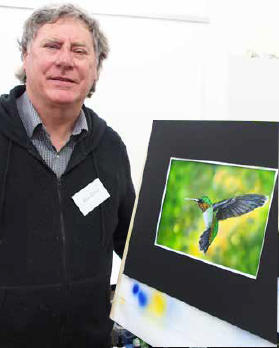 As always with Alan the preparation was perfect. He had set up three
aspects of his demo in great detail. He would start by giving us tips
on composition to help us make better, saleable pictures. This was a
five page handout, one for everybody and a memory stick of examples
from reputable artists to be shown on our AV screen. Then to illustrate
what he was to be talking about, he mounted a three stand exhibition of
his students’ work on bird studies with airbrush backgrounds.
As always with Alan the preparation was perfect. He had set up three
aspects of his demo in great detail. He would start by giving us tips
on composition to help us make better, saleable pictures. This was a
five page handout, one for everybody and a memory stick of examples
from reputable artists to be shown on our AV screen. Then to illustrate
what he was to be talking about, he mounted a three stand exhibition of
his students’ work on bird studies with airbrush backgrounds.
Thirdly Alan had a bird picture onto which he demonstrated how to to spray with the airbrush a colourful background. Like all good teachers he could feel confident that if the preparation is good the lesson will go well. And it did.
The Fundamentals of Composition by Alan Close was his five page handout. Very generous. If you have a copy of this, hang on to it. It is not just good, it is crucial. I won’t summarise it, just get yourself a copy. Alan may have a few spares. He went through it while Col Foster supported him with relevant visuals on the screen.
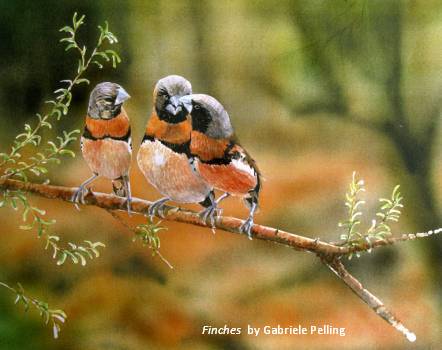 Finches
by Gabriele Pelling
Finches
by Gabriele Pelling
You should do a small tonal sketch before you commit to your good paper. Some of the headings were The Rule of Thirds, The Focal Point, Lightest Light on Darkest Dark, Lead-ins, Bullseye, Balance and Space, Space to Travel Into, Dark in one Corner. To elaborate on them would take me as long as it took Alan to speak. There was a wealth of material and tips to improve your art. Amazingly he did this in less than an hour before afternoon tea. During the break we had a chance to marvel at his students’ work on airbrushing the backgrounds of birds they had painted in watercolour. They were amazing, totally professional. “How did they do that?” The answers came next.
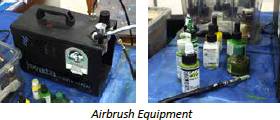 Alan had the (expensive) equipment set up. It was a compressor with air
pressure set at 40psi. An airhose connected the compressor to the
airbrush. The airbrush itself had a reservoir to hold Schminke acrylic
paint and a trigger to release bursts of it. The closer you hold the
airbrush nozzle to the paper the more intense and small the spray mark.
At a distance you get a soft puffy mark. But first you have to protect
your precious bird painting.
Alan had the (expensive) equipment set up. It was a compressor with air
pressure set at 40psi. An airhose connected the compressor to the
airbrush. The airbrush itself had a reservoir to hold Schminke acrylic
paint and a trigger to release bursts of it. The closer you hold the
airbrush nozzle to the paper the more intense and small the spray mark.
At a distance you get a soft puffy mark. But first you have to protect
your precious bird painting.
.jpg) To do this you use frisket, which is a two
layer Glad Wrap type of film. Peel off the backing layer and place on
your artwork sticky side down. You then very carefully cut through
with a scalpel leaving the bird covered. Some of the students had done
the cutting with exquisite care outlining minute soft feathers. Test
the spray. Use light colours at first. You can merge colours as in a
merged watercolour wash. The result is fantastic. You remove the
frisket with care, as it can damage the surface of your artwork if
pulled off carelessly.
To do this you use frisket, which is a two
layer Glad Wrap type of film. Peel off the backing layer and place on
your artwork sticky side down. You then very carefully cut through
with a scalpel leaving the bird covered. Some of the students had done
the cutting with exquisite care outlining minute soft feathers. Test
the spray. Use light colours at first. You can merge colours as in a
merged watercolour wash. The result is fantastic. You remove the
frisket with care, as it can damage the surface of your artwork if
pulled off carelessly.
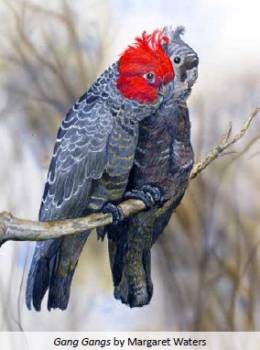
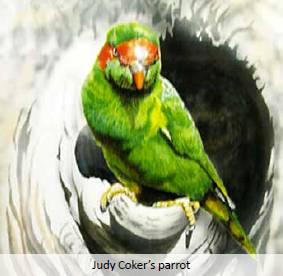
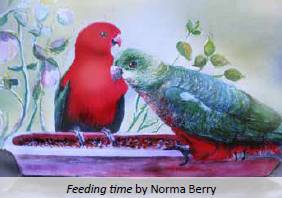
A demonstration to help you lift your game.
Report by Colin Browne